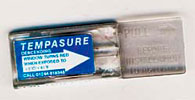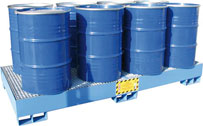No products
Prices do not include tax.
CONTROL OF FREEZING OF WATER PAINT
The use of a thermosensitive selfadhesive device to prevent the freezing of water paints. It's use during the transport and/or storage.
Purpose: one of the manufacturers of decorative and industrial paints with a more global presence contacted us looking for a solution to your problem. His paintings at water are at risk of freezing in the cold seasons, mainly in the countries of northern Europe. If the container freezes, the paint is completely unusable due to water base. If this happens, you would have to pull the drum with consequent economic loss that entails as it is very costly paint. In short, the manufacturer needed a solution to control the temperature of the product, both during transport as the storage period.
The thermosensitive product used: TEMPASURE D+5

Work done: The paint used for plastic accessories of the automoviles such as mirrors or bumpers, is a water-based paint. Obviously, the paint may suffer irreparable harm if its freezing temperature is reached even if only for a few minutes.
This critical temperature may occur at certain times: during transport, especially to northern Europe. It may occur during storage in cold seasons since these cans of paint may remain temporarily stored in outdoor enclosures.

The indicator chosen was the TEMPASURE ref.D +5 devices. This indicator is calibrated at +5 ° C. Its accuracy is +/- 2 ° C, which means that - if the container is subjected to a temperature between 3 ° C and + 7 ° C + - TEMPASURE D+5 clearly changes its color from transparent to deep purple. The size of the indicator allows its accession to the curved surface of the drum so that the direct reading of each drum is obtained. On the other hand, if temperature is critical or there is an unavoidable damage, we will be sure about what are the damaged drums and the intact drums.
This device has being used for this purpose for more than eight years ago. It is an easy way to implement it because it does not require installation and does not require batteries. It is ideal for controlling the temperature of all those materials whose impairment is a major economic loss: water paints - as in our case - but also liquid photographic or pharmaceutical among others.
